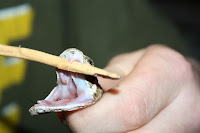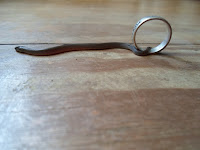I had a conversation last night very similar to many others I have had in the past. We were discussing North American snakes with a focus on the venomous ones. During the conversation the typical myths were brought up as well as the typical misunderstanding across the board in regards to this topic.
I decided to compile some of the information that I have gathered from my own personal experience and research through years of catching venomous and non-venomous snakes. I have so far skinned three of the four venomous snakes that are native to North America and I only need the Cottonmouth for its skin and a coral to complete my ‘bucket list’ of catches if you will. Over the years I have caught literally hundreds of snakes including worm snakes, racers, hognoses, ribbons, garters, rough greens, rats, gophers, Indigos, diamond backed water snakes, copperheads, as well as diamond back rattlers, just to name just a few... I was given a live coral snake that I skinned some years ago so that one does not count as caught…
I do have special tools that I have developed to catch these including a long PVC pole with a looped nylon rope running through it and a snake hook that I use in order to catch the highly venomous ones from a greater distance.



Here goes the list and some details around their venom types:

Rattlesnakes: Venom is hemotoxic and is destructive to tissue as well as inhibiting blood clotting. The Tiger and Mojave rattlesnakes also have a neurotoxic venom that causes paralysis. Very Potent and potentially deadly.

Copperheads: The venom is hemotoxic which results in temporary tissue damage. Considered to be the weakest of all North American venomous snakes and rarely do bites result in severe symptoms or death. Mildly potent.

Cottonmouths (Water Moccasins): The venom type is hemotoxic and causes hemorrhaging in the circulatory system. Very potent and potentially deadly.
Coral Snakes: they have the second strongest venom type in the world; and most potent venom in North America. Venom is difficult for the snake to deliver due to mouth structure and size. Venom is neurotoxic and can definitely kill a person although it is reported that no deaths have occurred since the 1960’s.
The venom causes extreme pain and can lead to heart attack.
Fangs are short and in order to deliver the venom it needs to literally chew on its victim.
The venom causes extreme pain and can lead to heart attack.
Fangs are short and in order to deliver the venom it needs to literally chew on its victim.
Dispelling some Myths:


Copperheads are considered deadly by a lot of people. The fact is Copperheads are not deadly. It is highly recommended that you give them as much respect as you would any other venomous snake due to the potential of you having an adverse reaction to the venom despite its lowered toxicity.

- Diamond shaped heads do not prove that a snake is venomous.
Hognose snakes have a distinct diamond shaped head and are not venomous. Coral Snakes do not have a diamond shaped head and are very venomous. As mentioned for the copperhead, just give them all plenty of respect and distance.


- Rattlesnakes are believed to rattle before a strike. This is not true in all cases. Just be on high alert when you are tromping through their habitats. You may stumble upon one that did not hear (feel) you coming. They sense vibrations through the ground…
- Many believe that baby snakes are more dangerous than adult snakes. This is false due to the fact that the venom of adult snakes is more potent (toxic) than the baby’s. Also, the adults produce and carry much more venom than the babies do. By far more dangerous bites have resulted from adult snakes than baby snakes. Either way, it’s highly recommended to give the same respect in regards to avoiding the babies as you would an adult.
- Rattlesnake is thought by many to taste like chicken. IMHO it does not but to each his own














- Many believe that the only good snake is a dead snake. Snakes, both venomous and non-venomous, kill a lot of rodents such as rats and mice. These pests that the snakes kill and eat poise a much greater danger to your well-being than any snake ever will as they carry diseases and are in general destructive to personal property. The odds of you being adversely affected by unhealthy and destructive pests is far greater than the odds of you ever being bitten by any snake let alone a venomous one.

















No comments:
Post a Comment